CONCEPT44.5 Community Ecology Suggests Strategies for Conserving Community Function
The ability of an ecological community to provide humans with critical goods and services often depends on its diversity. How can we use this knowledge to conserve community function?
Ecological communities provide humans with goods and services
Humans, like all species, depend on the ecological interactions that occur in communities and the interactions between communities and their physical environment. Although this seems obvious today, it was only in 1970 that ecosystems were first said to provide people with “goods and services.” The goods include food, clean water, clean air, building materials, and fuel; the services include flood control, soil stabilization, pollination of plants, and climate regulation. Because many of these goods and services involve exchanges between communities and the abiotic environment, they are called ecosystem services; a short list of examples is given in TABLE 44.1.
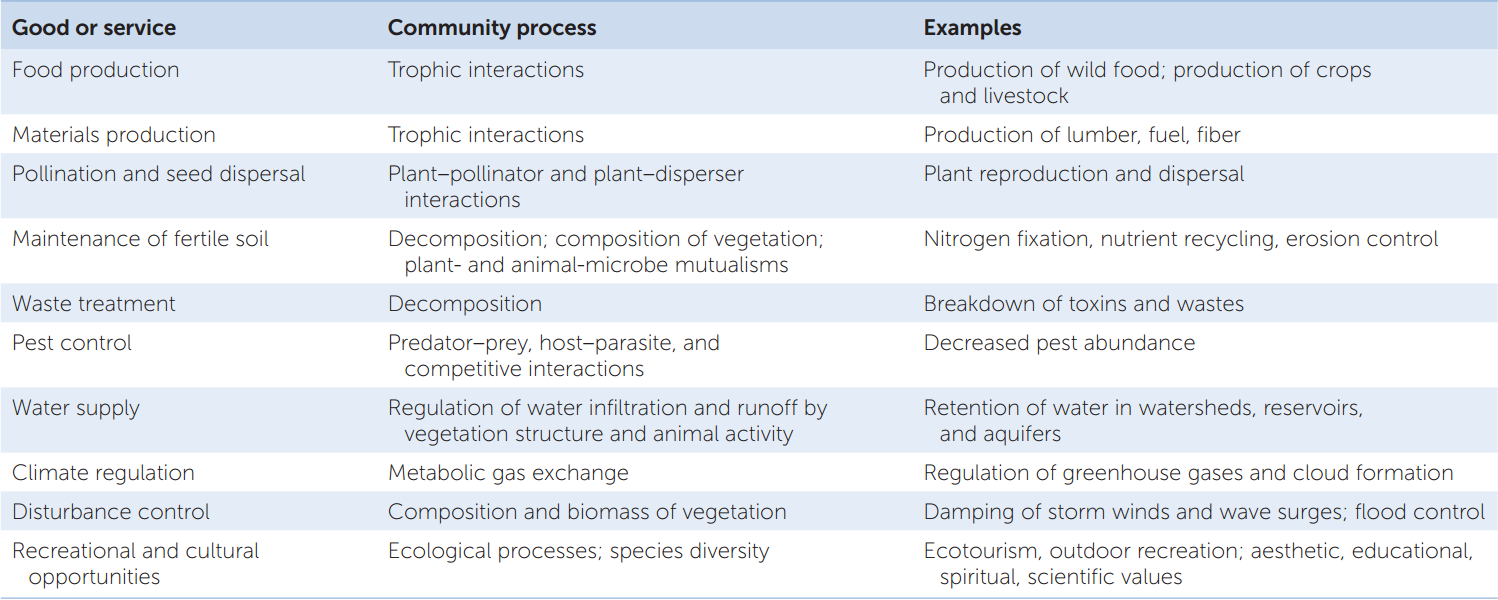
Goods that are of direct biological origin are obvious: everybody knows that we get food from plants and animals, wood from trees, wool from sheep, and aesthetic enjoyment from flowers and birds. The roles of properly functioning communities in providing ecosystem services are less obvious, however, and we often take them for granted—until something goes wrong.
European settlers of Australia learned the hard way about the importance of the services provided by decomposers. When the first settlers arrived in 1788, they brought cattle with them. From the beginning, however, the Australian cattle industry ran into problems: native dung beetles, adapted as they were to the dry, fibrous dung of forest marsupials, shunned the wet manure produced by cattle in open pastures. As a consequence, manure piled up higher and deeper. The accumulated dung not only reduced pasture productivity (because the nitrogen in the dung was not being recycled, and because cattle do not eat fouled plant material), but also provided a perfect nursery for native bush flies and introduced blood-sucking buffalo flies. Populations of these pests exploded.
In 1964, Australia’s national scientific research organization, CSIRO, finally tackled the problem. Insect biologists traveled the world to find dung beetles that could process cattle dung in Australian environments without disrupting native beetle communities—an important precaution, since many well-intended introductions have had unforeseen, detrimental impacts (see Concept 43.3). Between 1968 and 1984, CSIRO introduced more than 50 species of beetles. The project was successful: soil nitrogen content improved, pasture productivity increased, fly numbers plummeted, cattle became healthier, and native dung beetles were unharmed.
910
Diversity patterns provide clues to what determines diversity
An alternative to MacArthur and Wilson’s explanation for patterns of species richness on islands has been proposed: that any island has a particular mix of niches that support an islandspecific community. For Simberloff and Wilson’s mangrove islands (see Figure 44.12), this hypothesis would mean that each island gradually reassembled its original arthropod community, and that the number of species stopped changing when the full complement of species was restored. Review two additional results from the Simberloff and Wilson study shown below and answer the associated questions.a
- Figure A shows the original community and postdefaunation census results for individual arthropod species on one mangrove island. Do these census results support or refute the alternative hypothesis? Explain your answer.
- Figure B shows the accumulation of arthropod species in three functional groups—herbivores, carnivores, and parasites—for the same island. Did species in these three groups accumulate at the same rates? Why or why not?
aD. S. Simberloff and E. O. Wilson. 1969. Ecology 50(2): 278–296; J. W. Glasser. 1982. American Naturalist 119(3): 375–390.
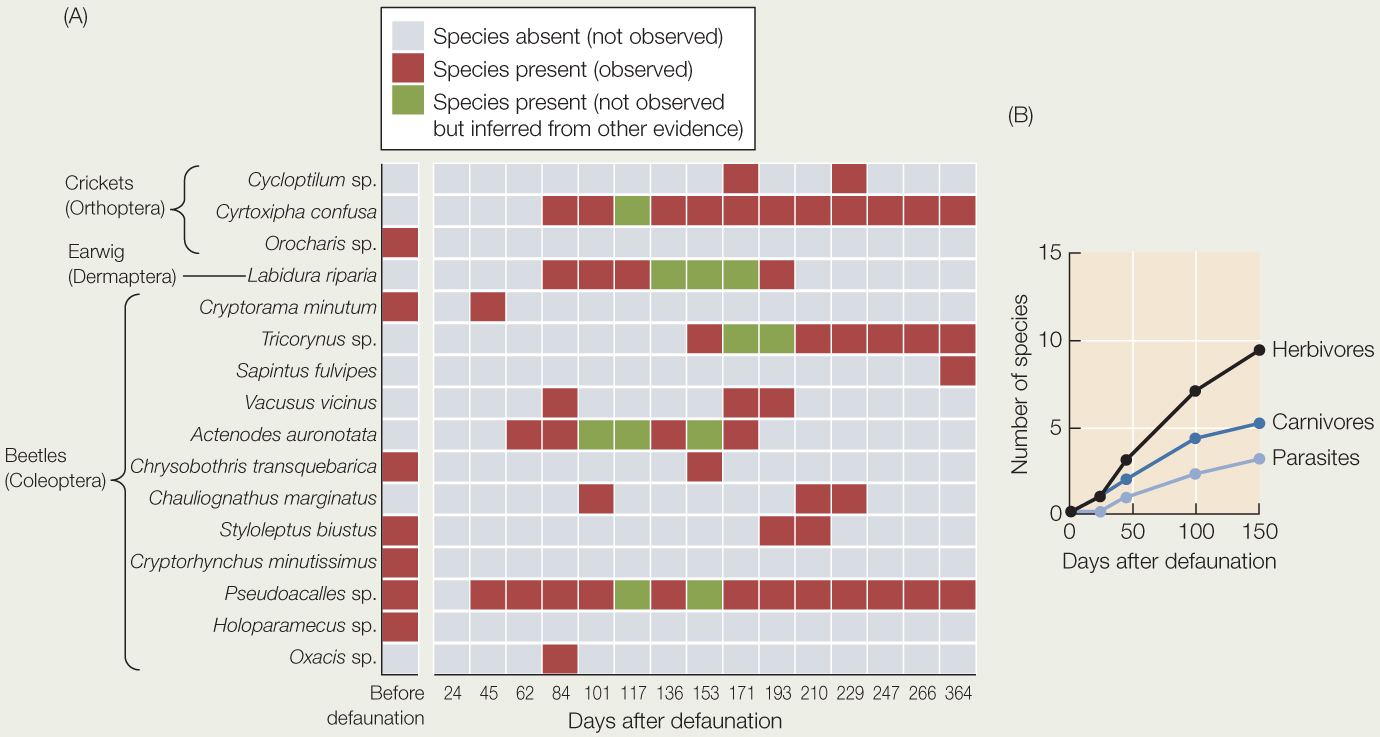
Ecosystem services have economic value
Ecosystem services have economic value, as the Australian Dung Beetle Project shows. Some services related to food production are relatively straightforward to value because they are included in the price of the food. In the United States, for instance, wild native pollinating insects (not including domesticated honey bees) contribute $3 billion annually to crop production. Many other services—such as greenhouse gas regulation—are more difficult to value because they are not included in commercial markets, but that does not mean they lack value.
Consider the case of New York City’s water, which comes from reservoirs in the Catskill Mountains. Natural ecosystems in the Catskills provided the city with pure water for many years. But conversion of forests into agricultural fields and housing developments eventually began to decrease water infiltration into the soil, thus increasing the discharge of sewage, fertilizers, pesticides, and sediment into streams. New York was faced with the prospect of building a new $6–$8 billion water treatment facility. When the city considered alternatives, it realized that it could meet federal water quality standards by investing $1.5 billion in land protection and better sewage treatment in the Catskills. Although expensive, this natural alternative cost a lot less than the technological alternative! New York’s Long-Term Watershed Protection Plan, completed in 2006, has been a complete success.
The New York example is not unique. Many ecosystems can provide more goods and services, at lower cost, than artificial substitutes can. But as we have seen, the community functions that deliver those goods and services depend on species diversity. Ecological communities can best meet our needs if we do not manage them so intensively, or disturb them so severely, that we lower their diversity.
911
Island biogeography suggests strategies for conserving community diversity
Concept 41.5 described how humans are converting natural communities into less diverse, human-managed communities such as croplands, pastures, and urban settlements. As a result, once-continuous areas of natural habitat are being reduced to scattered fragments—habitat islands embedded in human-modified landscapes (FIGURE 44.13). We expect such fragmentation of habitat to cause losses of species from communities for several reasons: the total amount of habitat decreases, the size of habitat patches decreases, and the patches become more isolated from one another. Given what you have learned about metapopulations (see Concept 42.5) and island biogeography, you now can predict the results. Subpopulations become smaller as habitat area shrinks and are therefore more prone to extinction. The human-dominated landscape surrounding the fragments may serve as a barrier to dispersal, decreasing colonization rates. The net consequence is lower species richness in the fragments than in the original habitat.
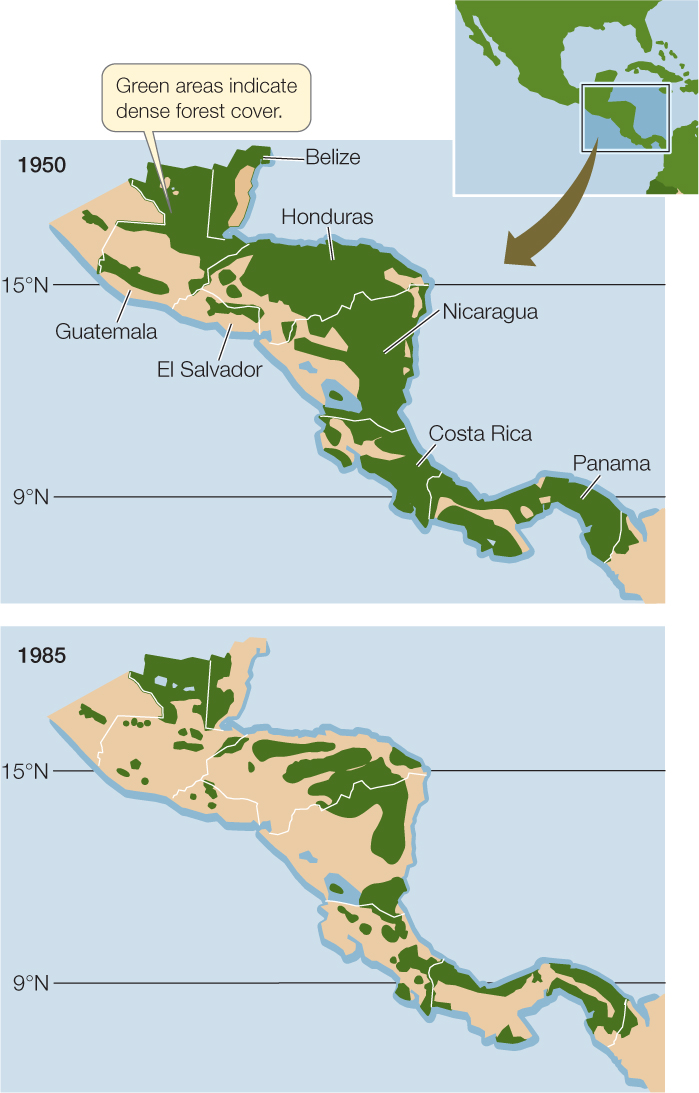
The insight that species richness reflects a balance between colonization and extinction suggests that the detrimental effects of fragmentation can be minimized by enhancing colonization and reducing extinction. Colonization rates can be increased by clustering habitat fragments close to one another or to a large “mainland” patch, or by connecting fragments with dispersal corridors (see Concept 42.6). Extinction rates can be minimized by retaining at least some large patches of the original habitat and by preserving the capacity of remaining patches to support healthy populations.
912
Several of these predictions have been tested in a remarkable large-scale experiment. Landowners in Brazil agreed to preserve tropical forest patches of certain sizes and configurations laid out by biologists (FIGURE 44.14), and they allowed the biologists to survey the parcels before and after the intervening forest was cleared for pasture. Species soon began to disappear from the patches. The first species lost were monkeys that travel over large areas of forest. Army ants and the birds that follow their columns also disappeared quickly. Species were lost more rapidly in isolated fragments than in fragments of equal area that were connected to nearby unfragmented forest, and small isolated fragments lost species more rapidly than larger isolates.
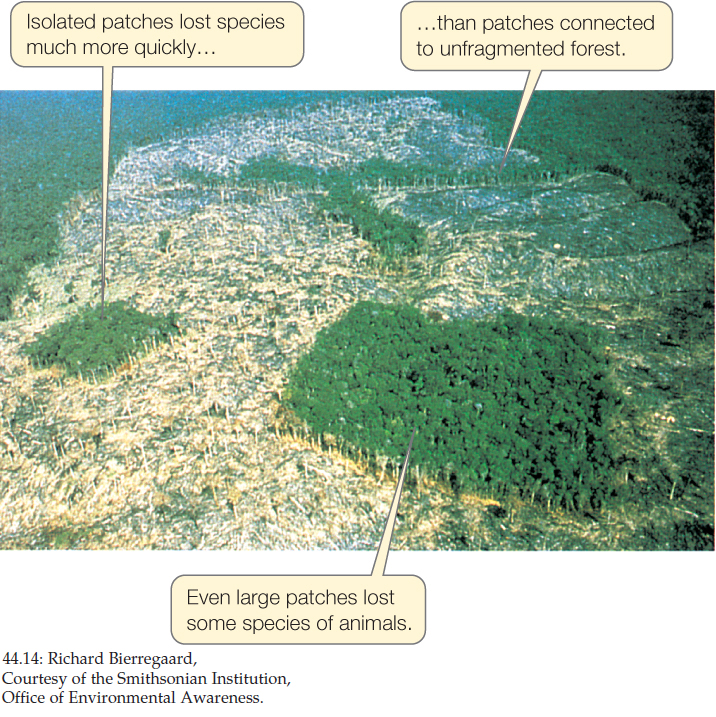
Results of studies such as these now guide land-use planning worldwide. They suggest that dispersal corridors and large habitat patches are necessary to maintain healthy, diverse communities.
Trophic cascades suggest the importance of conserving certain species
It is well and good to plan for dispersal corridors and large patches of habitat, but species differ considerably in their habitat area requirements and in the kinds of dispersal corridors they will use. How big should natural areas be? What constitutes an effective corridor? These decisions can often be facilitated if they target species that play particularly important roles in communities.
The wolves of Yellowstone National Park provide an example of a species whose presence has a major effect on community structure and function (see Concept 43.3). Wolves are crucial for maintaining healthy aspen forests and watersheds via trophic cascades that also involve elk, aspen and willow, and beavers. Conservation planning is now targeting such critical species. The Yellowstone to Yukon Conservation Initiative, for example, has the goal of maintaining a continuous corridor of wolf habitat between Yellowstone National Park and areas of similar habitat to the north, which should help maintain the Yellowstone wolf population and hence a healthy Yellowstone ecosystem.
The relationship of diversity to community function suggests strategies for restoring degraded habitats
We have seen that even highly disturbed communities, such as those on Krakatau or on experimentally defaunated mangrove islands, can recover. This insight from community ecology suggests that degraded ecosystems can often be restored—the goal of restoration ecology (see Concepts 41.5 and 43.3). The relationship between diversity and community function suggests that one of the best ways to improve the functioning of a damaged system is to restore species diversity. To do so, restoration ecologists draw on their knowledge of the factors that shape diversity (FIGURE 44.15).
Investigation
HYPOTHESIS
Faster progress toward restoring the community’s original function will be made by planting mixtures of species than by planting single species alone.
- In an area of wetland denuded of vegetation, mark off replicate small experimental plots, all of the same size.
- Choose 8 native species typical of the region. Plant some plots with each of the 8 species by itself, others with different 3-species subsets, and others with different 6-species subsets.
- Plant the same total number of seedlings per plot. Leave some plots unplanted as controls.
- Return over the next 18 months to measure the vegetation and ecosystem nitrogen levels.
Vegetation covered the bare ground more quickly in those plots with higher species richness. Those same plots developed complex vertical structure more quickly and accumulated more nitrogen in plant roots per m2 of area.

CONCLUSION
Planting more species into a community leads to more rapid restoration of wetland function.
ANALYZE THE DATA
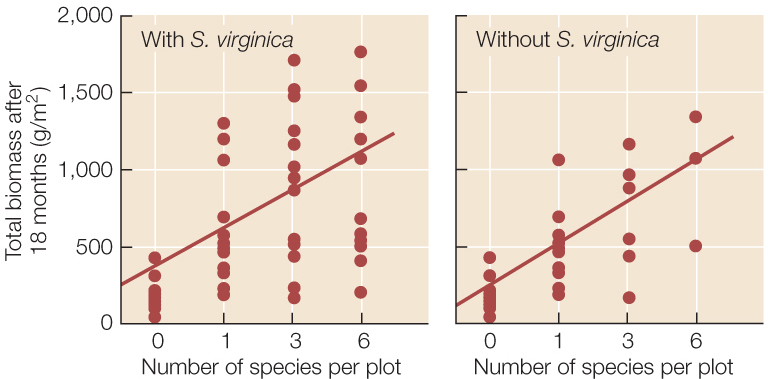
- The unplanted control plots (above) showed nonzero values of stored nitrogen after 18 months. Is this a surprise? Why or why not?
- One of the 8 species in the study, Salicornia virginica, contributed a disproportionate share of the biomass, cover, and nitrogen in mixtures in which it was included. In the two graphs at left, each circle represents the performance of a particular plot; the lines indicate best-fit regressions. Based on these two graphs, what do you conclude about the mechanism for the higher success of species-rich plantings? Is the greater chance of including S. virginica in species-rich plantings the likely explanation?
aG. H. Keer and J. B. Zedler. 2002. Ecological Applications 12: 456–473; J. C. Callaway et al. 2003. Ecological Applications 13: 1626–1639.
As we have also seen, however, disturbance sometimes results in an ecological transition to a community that is very different from the original community (see Concept 44.2). In such cases it may be difficult to find a way to reverse the transition and restore the function of the original community. This possibility is a sobering reminder that restoration is challenging and requires deep understanding of individual ecosystems.
CHECKpointCONCEPT44.5
- Give two examples each of goods and services provided to humans by natural ecosystems and by ecosystems constructed and managed by humans.
- If you were working as a restoration ecologist to restore a certain community, what measures might you use to assess whether your efforts were successful?
In this chapter we have discussed factors that influence the structure of communities and the interactions that shape the flow of energy through them. We have seen how community structure affects a community’s function, including its outputs of goods and services. But outputs are limited by inputs, and to understand what determines inputs to communities, we need to consider their abiotic environments. The next chapter will apply this ecosystem perspective and consider how humans are influencing the global ecosystem.
913
914
Can we use principles of community ecology to improve methods of coffee cultivation?
ANSWER Croplands are ecological communities that are governed by the same factors that govern natural communities. We can therefore use our understanding of how natural communities function to improve the functioning of agricultural communities. For example, we know from studying natural communities that species diversity often enhances community function (Concept 44.3)—whether we are talking about pest control, pollination, or crop yield. We also know that species diversity is increased when colonization rates are high and extinction rates are low, and when complex habitat structure provides opportunities for species with diverse niches to coexist (Concept 44.4). We can use these ecological principles in many situations to produce more food at less cost and with fewer negative effects on the environment. For example, we can enhance crop production by growing crops in complementary functional groups together, a practice known as “intercropping.” Planting coffee, which is shade-tolerant, in the shade of taller, timber-producing trees is an example of intercropping.
The desired output of coffee plantations is, of course, seeds (coffee “beans”). Although Coffea arabica flowers can pollinate themselves, seed production is enhanced when bees move pollen between individual plants. From our knowledge of community ecology, we might predict that diverse bee communities would provide the best pollination overall, because different bee species may pollinate in complementary ways. Recent research in Indonesia confirms this prediction: seed production was 50 percent higher, and varied less from year to year, in coffee plantations that hosted 20 wild bee species than in those that hosted 3 bee species.
We also know that wild species of insects are important for pollinating the flowers of most species of flowering plants. This knowledge suggests that embedding coffee plants in diverse natural communities of plants and animals might be an effective way to reap the benefits of better pollination. Research in both Costa Rica and Indonesia confirmed this prediction as well: planting coffee close to intact patches of forest and leaving flowering weeds in place (FIGURE 44.16) was all it took to attract a diverse bee community and thus increase production. This research is at the forefront of a new movement to enhance pollination and pest control services for crops by bordering croplands with species-rich and structurally diverse communities.
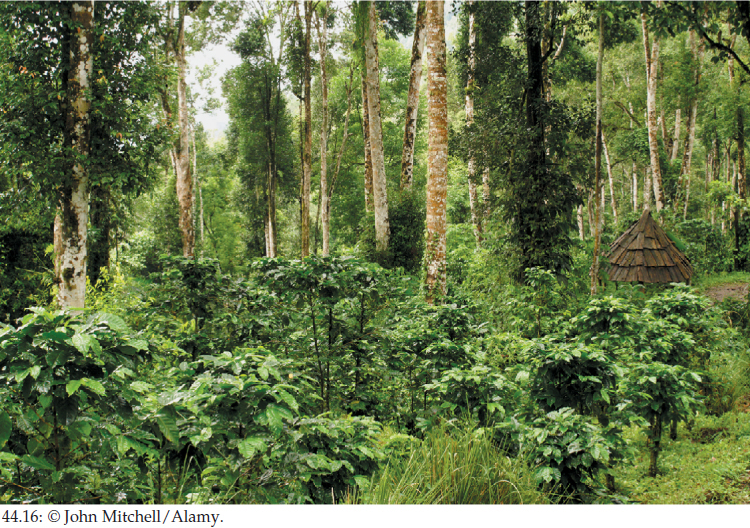
Traditional low-intensity cultivation methods therefore seem to be a cost-effective way to increase coffee production. Although traditional methods may not provide the highest yields per hectare, they may nevertheless be very profitable. A study of nine coffee plantations in Mexico reported that high-intensity sun cultivation produced more coffee per hectare, but that low-intensity plantations were more profitable because they reduced the costs of chemicals and labor. That low-intensity cultivation also avoids pollution and helps maintain diverse natural communities are added benefits of taking advantage of natural ecosystem services.
915